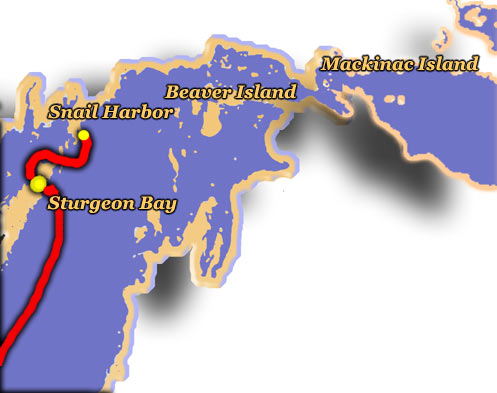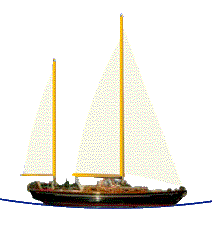



Ships Log August 3-4, 2005
We sailed out of Fish Creek on a broad reach in a pleasant southeast wind. For the past few days, the shores had been enveloped in a thick haze. The near hundred degree temperatures combined with a thermal inversion and the flow of air from cities in the south had created dense photochemical oxidant smog, unusual for the region. This substantially detracted from the view along the coast and the condition persisted until the evening's storm. At Porte Des Morts, we rounded the tip of the Door County Peninsula and encountered high winds and seas cutting across from Lake Michigan.
We decided to take refuge at Washington Island for lunch. The chart indicated a narrow and tricky passage into a large sheltered bay with sufficient depth. Jousting with numerous ferryboats, we took the slim passage past the ferry dock and back into the wild portion of the bay, finding the depth to be closer to 7 feet than the 10 on the chart. We anchored in thick weed beds and drug the length of the bay in high winds during lunch. We had intended to sail to Beaver Island that day, but the conditions dictated a change of plans. With violent storms predicted, we could not risk dragging anchor in Washington's weed beds, so we set out for our favorite little safe haven, Snail Harbor, 50 miles to the north.
We arrived at Snail on Garden Peninsula, Michigan shortly after sunset. The harbor is so named because it is shaped like a snail shell and the short 9-boat dock inside is protected from weather from all directions. The dock was fully occupied, so we anchored. The storm hit during the night. In the morning, we moved to the dock, hiked the surrounding state park and hung out with the other sailors that had found this snug little corner of the Lake. The harbor had been the site of Native American camps for at least three thousand years, but was timbered in the mid 1800's .
In 1867, the Jackson Iron Mill was constructed on the site to take advantage of the local wood for making charcoal, lime from the local cliffs, iron ore from mines nearby and the excellent harbor for shipping the finished iron pigs. The wood was tightly packed into the kilns and cooked with restricted oxygen flow for 8 days to produce pure carbon. This carbon was dumped into the blast furnaces along with the crushed iron ore and limestone. The carbon formed the heating fuel and the limestone went into solution, absorbed the impurities from the molten ore and was poured off as slag. The remaining liquid iron was tapped into forms and cooled into 100-pound ingots or "pigs". The income of the workers, who came primarily from Canada and the British Isles, averaged $1.60 per day for 12 hours work. The Company hotel on site charged $2.00 per night for a room. During their 24 years of operation, the blast furnaces produced 229,288 tons of iron before the company abandoned the works. The site is now a Michigan State Park.
For millennia, man lived in harmony with nature on this beautiful place. In the space of little more than 20 years, industrial man clear-cut the ancient timber and fouled the earth with toxic waste. Now Snail Harbor stands as an example of how the earth can recover when allowed to do so.
v